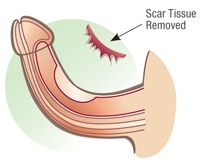While it may sound radical, surgical treatment can be an effective way to restore sexual function. There are two techniques:
- Surgical penile reconstruction with or without grafting
- Placement of penile prosthesis with straightening methods
Shortening the long (unaffected) side
The formation of scar tissue on one side of the penis will shorten that side, resulting in a curvature (Figure 1). Shortening the longer side of the penis can help create equal length on both sides (Figure 2). Although some shortening may occur, the amount of shortening is typically no more than 3/4 of an inch. This procedure is usually used for less severe cases of Peyronie’s disease.



Allograft
Scar tissue is cut or partially removed on the shorter (affected) side. After removal of this tissue, the defect is covered with a natural, soft graft material (Figure 3). The graft material offered by Coloplast has been used in more than 2 million implants. (3) It provides a safe, natural support when strength and security are needed.(4)



The length of the penis after the treatment is approximately equivalent to the longer side of the penis. This procedure is used for men with severe cases of the disease and no erectile dysfunction (ED).
Penile prosthesis
For men with ED and Peyronie’s Disease, a penile prosthesis may be the answer (Figure 4), followed by penile straightening with manual modelling.
Click here for more information about Titan® inflatable penile prostheses.